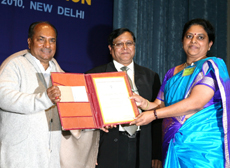|
 |
|
Tessy Thomas receiving an award
from Defence Minister A.K. Antony in the presence of DRDO
chief V.K. Saraswat in 2010.
(Photo:
DRDO) |
New Delhi: Forget
breaking the glass ceiling, Tessy Thomas has virtually blasted her
way through it. The 48-year-old is the first-ever woman director
of an Indian missile project and is set to place India in an elite
club of nations like the US, Russia and China with the capability
to produce their own long-range Inter-Continental Ballistic
Missiles (ICBMs).
She will achieve that when India tests its 5,000-km range nuclear
capable Agni-V missile by February 2012.
Thomas also wants to see Indian women taking on combat roles in
the armed forces.
"Why not? If they are performing other roles in the armed forces
so efficiently, they can also perform combat roles," Thomas told
IANS during a chat here.
"If women are willing to get into combat roles, I think, yes, they
should be allowed to join. This, I am sure, will happen over
time," said the 'Agni Putri' (Daughter of Fire), a sobriquet she
had earned for her association with the Agni missiles since 1988.
The scientist from the Defence Research and Development
Organisation (DRDO) was in Delhi after her team had successfully
tested the new-generation Agni-IV missile Nov 15 that broke new
records for India by hitting a target 3,000 km away from the
Balasore test range in the Orissa coast.
This is the first time ever the country has tested a missile to
hit target at that distance, thereby becoming the first Indian
missile to cross the equator and hit a target in the southern
hemisphere.
For her achievement in missile technology, she is also fondly
called 'the missile woman' by the Indian media.
When asked how she landed in the male-dominated defence research
and development world, she promptly replies: "Science has no
gender. Defence R&D is a knowledge-based field."
Armed with an engineering degree, Thomas joined the DRDO and was
assigned to work on the Agni missile project by none other than
former president A.P.J. Abdul Kalam, who is also known as the
'Father of Indian Missile Programme'.
She also has a masters in guided missiles technology.
She did her B.Tech from the Thrissur Engineering College at
Kozhikode and M.Tech from Pune-based Defence Institute of Advanced
Technologies. She was then selected for 'guided-weapon course'
being offered by DRDO and soon after, her saga with the Indian
missile programme began.
Since 1988, she has worked on Agni-series missiles and is also the
strength behind the 2,000-km range Agni-II and 3,500-km range Agni-III
missiles and has been the project director of these missile
programmes, contributing to the guidance designs. During her
initial years in the DRDO, she also worked on the 900-km range
Agni-I missile.
Her inspiration?
"Of course, Kalam sir. He was the director of the lab I joined
first and he was the one who assigned me to the Agni project."
Now at the helm of the Agni-V project, she supervises a work force
that comprises five other women scientists. The entire Agni
programme of DRDO has about 20 women among 250 scientists working
on the missile systems.
Thomas, who works at the Missile Complex of DRDO in Hyderabad,
first became project director of an Agni system in 2008, when she
was asked to head the Agni-II.
In July 2009, she was appointed the project director for the Agni-V
programme.
Last December, when Agni-II Prime (it was how Agni-IV was earlier
known) plunged into the Bay of Bengal just 30 seconds after launch
during its first-ever test, Thomas was disappointed.
"The first flight was a failure, though I won't call it a total
failure. We could record the first 30 second data for analysis of
some systems," she said.
But the second flight Nov 15 as Agni-IV was a grand success.
"We had an excellent launch. It is a tremendous feeling to prove
all the systems in one shot. We have data on all stages of the
flight and systems. We proved the whole system, most of which are
indigenous," Thomas told IANS.
What next? Wait for Agni-V, Thomas signs off.
(N.C. Bipindra can be
contacted at nc.bipindra@ians.in)
|



















